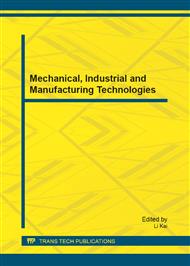[1]
S. Hesse, C. Bertelt, A. Schaffrin, M. Malezic, and K. H. Mauritz, Restoration of Gait in Nonamulatory Hemiparetic Patients by Treadmill Training with Partial Body-weight Support, Arch. Phys. Med. Rehabil., vol. 75, no. 10, Oct. 1994. p.1087–1093.
DOI: 10.1016/0003-9993(94)90083-3
Google Scholar
[2]
M. Visitin, H. Barbeau, N. Korner-Bitensky, and N. E. Mayo, A New Approach toRetrain Gait in Stroke Patients through Body Weight Support and Treadmill Stimulation, Stroke, vol. 29, no. 6, Jun. 1998, p.1122–1128.
DOI: 10.1161/01.str.29.6.1122
Google Scholar
[3]
Y. Laufer, R. Dickstein, Y. Chefez, and E. Marcovitz, The Effect of Treadmill Training on the Ambulation of Stroke Survivors in the Early Stages of Rehabilitation, J. Rehabil. Res. Dev., vol. 38, no. 1, Jan-Feb. 2001, p.69–78.
Google Scholar
[4]
G. Colombo, J. Matthias, S. Reinhard and M. Volker. Treadmill Training of Paraplegic Patients Using a Robotic Orthosis, Journal of Rehabilitation Research and Development, vol. 37, no. 6, Nov. -dec., 2000, pp.693-700.
Google Scholar
[5]
S. K. Banala, A. Kulpe and S. K. Agrawal, A pwered Leg Othosis for Gait Rehabilitation of Motor-Impaired Patients, Proc. IEEE International Conferrence on Robotics and Automation, IEEE Press, Apr. 2007, pp.4140-4145.
DOI: 10.1109/robot.2007.364115
Google Scholar
[6]
K. K. Mankala, S. K. Banala and S. K. Agrawal, Passive Swing Assistive Exoskeletons for Motor-Incomplete Spinal Cord Injury Patients, Proc. IEEE International Conferrence on Robotics and Automation, IEEE Press, Apr. 2007, pp.3761-3766.
DOI: 10.1109/robot.2007.364055
Google Scholar
[7]
C. Fang, W. Rencheng and J. Xiaohong, The Progress of Partial Body Weight Support Treadmill Robots, Chinese Journal of Rehabilitation Medicine, vol. 31, no. 2, Apr. 2008, pp.366-368.
Google Scholar
[8]
R. Riener, L. Lünenburger and S. Jezernik, Patient-cooperative Strategies for Robot-Aided Treadmill Training: First Experimental Results, IEEE Transactions on Neuronal Systems and Rehabilitation Engineering, vol. 3, no. 13, Mar. 2005, pp.380-394.
DOI: 10.1109/tnsre.2005.848628
Google Scholar
[9]
M. Bernhardt,M. Frey, G. Colombo and R. Riener, Hybrid Force-Position Control Yields Cooperative Behaviour of the Rehabilitation Robot LOKOMAT, Proc. IEEE 9th International Conference on Rehabilitation Robotics, IEEE Press, Jun. 2005. pp.536-539.
DOI: 10.1109/icorr.2005.1501159
Google Scholar
[10]
E. H. Asseldonk, J. F. Veneman, R. Ekkelenkamp, et al, The Effects on Kinematics and Muscle Activity of Walking in a Robotic Gait Trainer during Zero-force Control, IEEE Transactions on Neural Systems and Rehabilitation Engineering, vol. 16, no. 4, Aug. 2008, pp.360-370.
DOI: 10.1109/tnsre.2008.925074
Google Scholar
[11]
R. Ekkelenkamp, J. F. Veneman, H. Kooij van der, LOPES: Selective Control of Gait Functions during the Gait Rehabilitation of CVA Patients, Proc. IEEE 9th International Conference on Rehabilitation Robotics, IEEE Press, Jun. 2005, pp.361-364.
DOI: 10.1109/icorr.2005.1501120
Google Scholar
[12]
J. Ming-Shaung, K. Chou-ching, L. Dong-Huang, H. Ing-Shiou and C. Shu-Min, A Rehabilitation Robot with Force-position Hybrid Fuzzy Controller: Hybrid Fuzzy Control of Rehabilitation Robot, IEEE Trans Neural Syst Rehabil Eng, vol. 13, no. 3, Sep. 2005, pp.349-358.
DOI: 10.1109/tnsre.2005.847354
Google Scholar
[13]
D. Erol, N. Sarkar. Intelligent Control Framework for Robotic Rehabilitation after Stroke, Proc. IEEE International Conference on Robotics and Automation, IEEE Press, Apr. 2007, pp.1238-1243, doi: 10. 1109/ROBOT. 2007. 363154.
DOI: 10.1109/robot.2007.363154
Google Scholar
[14]
Feng Zhiguo, Qian Jinwu, Zhang Yanan, etal. Biomechanical Design of the Powered Gait Orthosis, Proc. Proceedings of the 2007 International Conference on Robotics and Biomimetics, IEEE Press, Dec. 2007, pp.1698-1702.
DOI: 10.1109/robio.2007.4522421
Google Scholar


